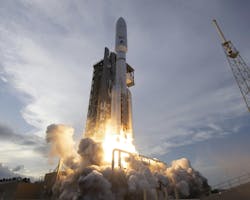Amazon launches first operational satellites for Project Kuiper from Cape Canaveral
CAPE CANAVERAL, Fla. - A United Launch Alliance (ULA) Atlas V rocket lifted off from Cape Canaveral Space Force Station in Florida on 28 April, marking the start of full-scale deployment for Amazon’s Project Kuiper. The mission, dubbed Kuiper-1, launched the first batch of production satellites in Amazon’s plan to create a broadband internet network using a constellation of more than 3,200 satellites in low Earth orbit (LEO).
The satellites aboard the KA-01 mission are the first in Amazon’s operational fleet and incorporate several upgrades from two prototypes launched in 2023. These improvements include enhanced phased array antennas for dynamic beam steering, upgraded onboard processors, more efficient solar arrays, refined Hall-effect electric propulsion systems, and new optical inter-satellite links (OISLs). The OISLs use infrared lasers capable of 100 Gbps data transfer, allowing satellites to relay data directly among themselves without relying solely on ground stations.
"This launch is an incredible milestone in Amazon's ambitious initiative to provide fast, reliable broadband service to unserved and underserved communities around the world," said Gary Wentz, ULA vice president of Government and Commercial Programs.
Future plans
Seven more Atlas V launches are planned for Project Kuiper, with an additional 38 missions slated aboard ULA’s next-generation Vulcan Centaur rocket. Amazon has also contracted launches with Arianespace, Blue Origin, and SpaceX to complete the deployment of its first-generation constellation.
"This launch marks the first step towards the future of our partnership and increased launch cadence," said ULA CEO Tory Bruno. "The addition of a second launch processing capability allows for dual, simultaneous launch processing between both integration facilities."
Amazon says it expects to begin customer service later in 2025, initially targeting remote and underserved regions. The Kuiper system aims to provide high-speed, low-latency internet globally, competing with existing satellite internet services like SpaceX’s Starlink.
"We’ve designed some of the most advanced communications satellites ever built," said Rajeev Badyal, vice president of Project Kuiper. "Every launch is an opportunity to add more capacity and coverage to our network... and we have all the pieces in place to learn and adapt as we prepare to launch again and again over the coming years."
About the Author

Jamie Whitney
Jamie Whitney joined the staff of Military & Aerospace Electronics and Intelligent Aerospace. He brings seven years of print newspaper experience to the aerospace and defense electronics industry.
Whitney oversees editorial content for the Intelligent Aerospace Website, as well as produce news and features for Military & Aerospace Electronics, attend industry events, produce Webcasts, oversee print production of Military & Aerospace Electronics, and expand the Intelligent Aerospace and Military & Aerospace Electronics franchises with new and innovative content.
